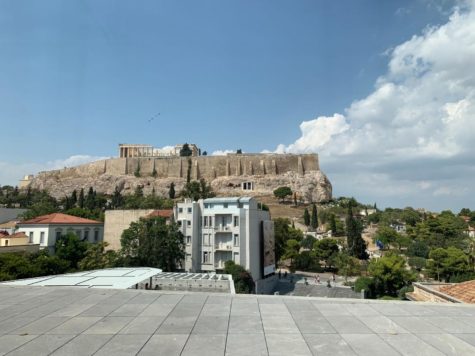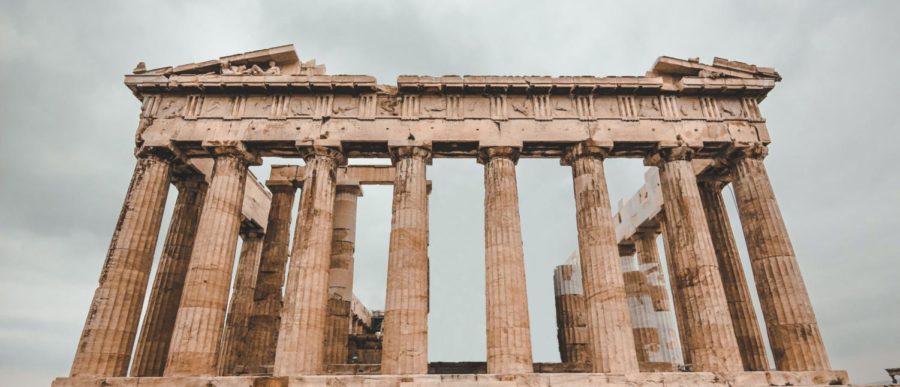Give Back the Elgin Marbles
The Parthenon is the defining symbol of Greece, but the marble sculptures which adorned its pediments and hold an especially prominent cultural significance were taken by a British Lord through questionable means.
Miltiadis Fragkidis / Unsplash
The Parthenon’s most recent restoration project was completed during the COVID-19 pandemic. However, the project came with controversy, as it paved over much of the Acropolis’ natural terrain.
The year was 1687. The towering Doric columns, ornate marble metopes, and friezes of the Parthenon stood strong in their faded glory. The marble behemoth had long lost the colorful hues decorating its walls and its golden ivory centerpiece, but at least it was still intact.
The Parthenon had been constructed during Athens’ golden age, thirty-three years after the second failed Persian invasion. Pericles, the great Athenian statesman, commissioned its construction (from 447 BCE to 432 BCE), and he dedicated the temple to Athena, the patron goddess of Athens in 438 BCE. It took an additional six years in order to complete the sculptures, which decorated both the exterior and interior of the Parthenon.
As the largest and most lavish Greek temple ever constructed, the Parthenon became a defining symbol of the Athenian golden age. Its looming size and splendor reflected the wealth and power that Athens had accumulated as head of the Delian league, a military alliance amongst Greek city states. There were fine decorative pediments that depicted the birth of Athena and her competition with Poseidon in order to sponsor Athens.
The frieze depicted the Panathenaic Procession and the battle of Marathon, an Athenian triumph, alongside other stories which reflect the Greeks’ prestige, strength, and culture. At the time, the Parthenon was painted in rich bright colors and housed a towering statue of Athena made of ivory and gold.
The elaborateness of the Temple drew criticism from non-Athenian cities, especially many Delian league members who paid Athens a substantial tribute in turn for protection. They viewed the Temple as garish and ostentatious. Regardless, it was the heart of the Acropolis and a defining symbol of Athens.
But the splendor of the age of Athens could not last. In 404 BCE, Sparta conquered Athens following Pericles’ death, and all of Greece eventually fell to Alexander the Great in 338 BCE. Athens faced a long, tumultuous period of conquest where its control shifted hands rapidly.
In 1459, the Parthenon had been converted into a mosque after the Ottomans seized Athens from its Florentine rulers. Before that, the Parthenon served as a Christian church after the Byzantine Empire outlawed all other religions.
Despite the succession of rulers, fires, and earthquakes, the Parthenon remained mostly intact. Its centerpiece was long gone, as were some of the finer decorations, but until 1687 the Parthenon’s time as a holy site for two other religions had served it well.
The Christian league sought to reclaim the Holy Lands and fought the Ottomans over Athens. Prior to that, Athens served as a small, mostly forgotten provincial town. The Ottomans sought defenses behind the enormous walls and columns of the Parthenon and used it for both ammunition storage and as a shelter. Cannonballs battered the structure and an ill-fated interaction with the stored ammunition destroyed the Temple.
The ruins were looted and the best sculptures were taken by Lord Elgin from England after he bribed Ottoman officials. Today, about half of the Parthenon’s frieze resides within the British Museum, after Elgin sold them to the museum when he went bankrupt. He spent about 70,000 British pounds to acquire and transport the marbles to England, but the British Parliament would only pay half of that. At the time, there were people who opposed the acquisition of the marbles, citing Elgin’s questionable method of acquisition. However, an investigation by the British Parliament found the process was legal and placed the marbles within the British Museum.
The marbles are highly contested. Greece now requests that the marbles be returned because they were acquired during the Ottoman occupation. However, the British Museum refuses, because they claim that the marbles were taken rightfully. The British Museum states they are open to loaning the artifacts, but the Board of Trustees will not return the marbles. Greece has vowed to not accept any loans, only the return of the marbles.

The marbles represent the Greek people’s historical and cultural heritage. The Parthenon is a source of their pride, and the missing marbles are an ever-bitter wound. They were taken when a foreign empire ruled over them, and the people had no say over their own historical treasures. The British Museum states that the artifacts were acquired using a proper license, but ignores the fact the license was not only acquired through bribery, but also from a nation with no right to dictate the fate of the Parthenon.
“I think that the British museum should give the marbles back, because even if taking them was technically legal at the time, the Greeks themselves weren’t the ones who handed the marbles to the British. They are not asking for something back that they willfully gave; rather, they are asking for something back that was stolen from them without their consent,” said Maggie Schneider ’22.
The British Museum has other highly contested artifacts, but none are more famous than the Elgin marbles. The best preserved half of the Parthenon’s Frieze is in the British Museum, divorced from its origin and from its compatriot pieces at the Acropolis Museum in Athens, Greece. Although British public sentiment has been growing in favor of returning the marbles to Greece, the Museum’s Board has claimed that the marbles are best suited to remain in the British Museum. They claim it represents the Global Heritage of the world and the resources of the British Museum allow them to be better preserved.
“As someone who is British, I think the British Museum’s position makes no sense. The Elgin Marbles are a part of a global heritage, but they are Greek, first and foremost. Giving back the marbles to Greece would not prevent people from seeing them. It would actually make more sense to see the entire collection [in Athens] where the Parthenon is, rather than having to go to London to see the other half,” said Sophia Randall ’22.
In response to claims about Greek museums not being sufficient to house the Elgin Marbles, the Greek government constructed the Acropolis Museum specifically to host artifacts from the Parthenon. The Museum was designed to have a full view of the Acropolis and the Parthenon, which allow visitors to view restored friezes and sculptures while gazing at a reminder of their origins.
Although prospects for a full return seem small, an Italian museum recently returned a foot piece to the Parthenon Museum. With these actions in mind, the British Museum has no excuse for their refusal to return what rightfully belongs to Greece and their people.
“I think that the British museum should give the marbles back, because even if taking them was technically legal at the time, the Greeks themselves weren’t the ones who handed the marbles to the British. They are not asking for something back that they willfully gave; rather, they are asking for something back that was stolen from them without their consent,” said Maggie Schneider ’22.

Carolyn Chui is an Editor-in-Chief for ‘The Science Survey.’ She enjoys writing articles on politics, business, and international relations. Carolyn...











